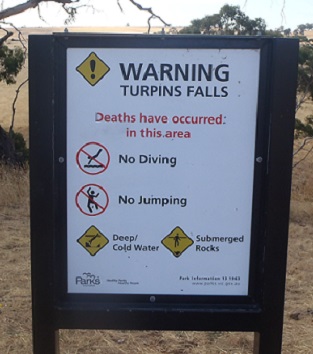| ← Back | Next → |
General Safety InformationWaterfall Seasons - The Waterfall Guide
| Home Page |
| Other Information: |
| Safety Info |
| Map |
| Your Support |
 Waterfalls are mostly well managed for safety, with local risks displayed by local signage and
indicated by protective barriers. Please observe these signs and barriers, and make your own assessment of
risk independent of anything presented on this guide. Conditions can vary markedly from waterfall to waterfall,
and can change rapidly at individual waterfalls in response to rainfall.
Waterfalls are mostly well managed for safety, with local risks displayed by local signage and
indicated by protective barriers. Please observe these signs and barriers, and make your own assessment of
risk independent of anything presented on this guide. Conditions can vary markedly from waterfall to waterfall,
and can change rapidly at individual waterfalls in response to rainfall.
There is always the temptation to get as close as you possibly can to a waterfall, or to try to reach that special spot where you think you will get the best view. Remember to think first before you move, identify hazards and assess the risks, including the risks of serious injury or death. The likelihood of getting medical attention quickly at many waterfalls is low.
In addition to any specific advice that may be available from local jurisdictions, some of the risks to be mindful of at waterfalls include:
- risk of drowning by getting too close to the water;
- slipping on wet rocks, loose rocks or steep slopes;
- an attack of vertigo by getting too close to a waterfall edge;
- Beware of animal hazards, such as crocodiles, snakes, leeches, ticks, etc. Animal hazards are generally site specific, so heed warning signs and research local waterfall safety information if you are visiting an area where you do not know or understand the local animal hazards. Light coloured clothing is recommended for areas with march flies, mosquitos, ticks or leeches, so that it is easier to see these animals when they are on your clothing;
- Use a sunscreen to avoid sunburn and skin cancer;
- Use an insect repellant, particularly if you are travelling into bush or jungle;
- Avoid swimming directly under waterfalls. Any debris flowing over the waterfall could cause injury if it hits you from above. At many larger waterfalls, water turbulence at the base of the waterfall under cuts the rock face, creating a rock ledge (sometimes submerged and not visible from the surface) and undercurrents that can both push you under the water and jam you underneath the rock ledge. Over my time documenting swimming holes, several people have drowned as a result of being sucked under large waterfalls.
- Be extra careful when it rains. After heavy rain, rivers can swell quickly. Roads can be cutoff and washed away, so if the weather is wet, take extra care and seek advice from emergency services in your local area;
- Be extra careful during bushfire weather. Seek advice from emergency services in your local area during days of high fire danger. If you sense any fire danger, act early and act quickly, as fire can move very fast. Plan alternative exit routes in remote areas before you visit your waterfall; and
- Above all, use your common sense. Conditions can change rapidly. Continually re-assess the risks and act accordingly, which may include deciding not to visit. In addition to the above checklist, do your own independent safety planning and risk management before you visit your waterfall.
If you don't view a waterfall safely, it could be the last one you ever see, so be safe and enjoy as many waterfalls as you can. Here is a list of waterfall accessories that I use to reduce some of the above risks.
| ← Back | Next → |
| Home Page | Local Home Page |
| Safety Info | Map |
| List of Lists | Your Support |
| Feedback | Media |
|
|
|
|
|
|
|
|
|
|
© Brad Neal 2024. All rights reserved. Here are my
affiliate links and cookies policy and opportunities to provide support to Waterfall Seasons.